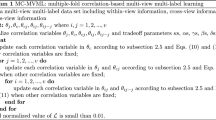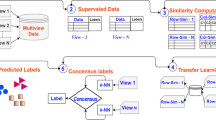Abstract
Multi-view learning or learning with multiple distinct feature sets is a rapidly growing direction in machine learning with well theoretical underpinnings and great practical success. This paper reviews theories developed to understand the properties and behaviors of multi-view learning and gives a taxonomy of approaches according to the machine learning mechanisms involved and the fashions in which multiple views are exploited. This survey aims to provide an insightful organization of current developments in the field of multi-view learning, identify their limitations, and give suggestions for further research. One feature of this survey is that we attempt to point out specific open problems which can hopefully be useful to promote the research of multi-view machine learning.
Similar content being viewed by others
References
Abney S (2002) Bootstrapping. Proceedings of the 40th annual meeting of the association for computational linguistics, pp 360–367
Archambeau C, Bach F (2009) Sparse probabilistic projections. Adv Neural Inform Process Syst 21:17–24
Bach F, Jordan M (2002) Kernel independent component analysis. J Mach Learn Res 3:1–48
Balcan MF, Blum A (2005) A PAC-style model for learning from labeled and unlabeled data. Proceedings of the 18th annual conference on computational learning theory, pp 111–126
Balcan MF, Blum A, Yang K (2005) Co-training and expansion: towards bridging theory and practice. Adv Neural Inform Process Syst 17:89–96
Bartlett P, Mendelson S (2002) Rademacher and Gaussian complexities: risk bounds and structural results. J Mach Learn Res 3:463–482
Bickel S, Scheffer T (2004) Multi-view clustering. Proceedings of the 4th IEEE international conference on data mining, pp 19–26
Blum A, Mitchell T (1998) Combining labeled and unlabeled data with co-training. Proceedings of the 11th annual conference on computational learning theory, pp 92–100
Brefeld U, Büscher C, Scheffer T (2005) Multi-view discriminative sequential learning. Lect Notes Aritif Intell 3720:60–71
Chen X, Liu H, Carbonell J (2012) Structured sparse canonical correlation analysis. Proceedings of the 15th international conference on artificial intelligence and statistics, pp 199–207
Chen Q, Sun S (2009) Hierarchical multi-view Fisher discriminant analysis. Lect Notes Comput Sci 5864:289–298
Chen M, Weinberger K, Blitzer J (2011) Co-training for domain adaptation. Adv Neural Inform Process Syst 24: 2456–2464
Collins M, Singer Y (1999) Unsupervised models for named entity classification. Proceedings of the Joint SIGDAT conference on empirical methods in natural language processing and very large corpora, pp 100–110
Dasgupta S, Littman M, McAllester D (2002) PAC generalization bounds for co-training. Adv Neural Inform Process Syst 14:375–382
de Sa V, Gallagher P, Lewis J, Malave V (2010) Multi-view kernel construction. Mach Learn 79:47–71
Farquhar J, Hardoon D, Meng H, Shawe-Taylor J, Szedmak S (2006) Two view learning: SVM-2K, theory and practice. Adv Neural Inform Process Syst 18:355–362
Fyfe C, Lai P (2000) ICA using kernel canonical correlation analysis. Proceedings of the international workshop on independent component analysis and blind singal separation, pp 279–284
Ganchev K, Graça J, Blitzer J, Taskar B (2008) Multi-view learning over structured and non-identical outputs. Proceedings of the 24th conference on uncertainty in artificial intelligence, pp 204–211
Hardoon D, Shawe-Taylor J (2009) Convergence analysis of kernel canonical correlation analysis: theory and practice. Mach Learn 74:23–38
Hardoon D, Shawe-Taylor J (2011) Sparse canonical correlation analysis. Mach Learn 83:331–353
Hotelling H (1936) Relations between two sets of variates. Biometrika 28:321–377
Kettenring J (1971) Canonical analysis of several sets of variables. Biometrika 58:433–451
Kumar A, Daumé H (2011) A co-training approach for multi-view spectral clustering. Proceedings of the 28th international conference on machine learning, pp 393–400
Kumar A, Rai P, Daumé H (2011) Co-regularized multi-view spectral clustering. Adv Neural Inform Process Syst 24:1413–1421
Langford J (2005) Tutorial on practical prediction theory for classification. J Mach Learn Res 6:273–306
McAllester D (1999) PAC-Bayesian model averaging. Proceedings of the 12th annual conference on computational learning theory, pp 164–170
Mitchell T (1997) Machine learning. McGraw Hill, New York
Muslea I, Minton S, Knoblock C (2006) Active learning with multiple views. J Artif Intell Res 27:203–233
Nigam K, Ghani R (2000) Analyzing the effectiveness and applicability of co-training. Proceedings of the 9th international conference on information and knowledge management, pp 86–93
Parrado-Hernández E, Ambroladze A, Shawe-Taylor J, Sun S (2012) PAC-Bayes bounds with data dependent priors. J Mach Learn Res 13:3507–3531
Rosenberg D, Bartlett P (2007) The Rademacher complexity of co-regularized kernel classes. J Mach Learn Res Workshop Conf Proc 2:396–403
Rosenberg D, Sindhwani V, Bartlett P, Niyogi P (2009) Multiview point cloud kernels for semisupervised learning. IEEE Signal Process Mag 145:145–150
Shawe-Taylor J, Cristianini N (2004) Kernel methods for pattern analysis. Cambridge University Press, Cambridge, UK
Shawe-Taylor J, Sun S (2013) Kernel methods and support vector machines. Book Chapter for E-Reference Signal Processing, Elsevier
Sindhwani V, Niyogi P, Belkin M (2005) A co-regularization approach to semi-supervised learning with multiple views. Proceedings of the workshop on learning with multiple views, pp 824–831
Sindhwani V, Rosenberg D (2008) An RKHS for multi-view learning and manifold co-regularization. Proceedings of the 25th international conference on machine learning, pp 976–983
Sun S (2010) Local within-class accuracies for weighting individual outputs in multiple classifier systems. Pattern Recognit Lett 31:119–124
Sun S (2011) Multi-view Laplacian support vector machines. Lect Notes Artif Intell 7121:209–222
Sun S, Jin F (2011) Robust co-training. Int J Pattern Recognit Artif Intell 25:1113–1126
Sun S, Jin F, Tu W (2011). View construction for multi-view semi-supervised learning. Lect Notes Comput Sci 6675:595–601
Sun S, Hardoon D (2010) Active learning with extremely sparse labeled examples. Neurocomputing 73:2980–2988
Sun S, Shawe-Taylor J (2010) Sparse semi-supervised learning using conjugate functions. J Mach Learn Res 11:2423–2455
Sun S, Zhang C (2007) Subspace ensembles for classification. Phys A Stat Mech Appl 385:199–207
Sun S, Zhang C, Lu Y (2008) The random electrode selection ensemble for EEG signal classification. Pattern Recognit 41:1663–1675
Sun S, Zhang Q (2011) Multiple-view multiple-learner semi-supervised learning. Neural Process Lett 34:229–240
Szedmak S, Shawe-Taylor J (2007) Synthesis of maximum margin and multiview learning using unlabeled data. Neurocomputing 70:1254–1264
Tzortzis G, Likas A (2009) Convex mixture models for multi-view clustering. Lect Notes Comput Sci 5769:205–214
Wang W, Zhou Z (2007) Analyzing co-training style algorithms. Lect Notes Artif Intell 4701:454–465
Wang W, Zhou Z (2010) A new analysis of co-training. Proceedings of the 27th international conference on machine learning, pp 1135–1142
White M, Yu Y, Zhang X, Schuurmans D (2012) Convex multi-view subspace learning. Adv Neural Inform Process Syst 25:1–9
Xu Z, Sun S (2010) An algorithm on multi-view Adaboost. Lect Notes Comput Sci 6443:355–362
Xu Z, Sun S (2011) Multi-view transfer learning with Adaboost. Proceedings of the 23rd IEEE international conference on tools with artificial intelligence, pp 399–402
Xu Z, Sun S (2012) Multi-source transfer learning with multi-view Adaboost. Lect Notes Comput Sci 7665:332–339
Yu S, Krishnapuram B, Rosales R, Rao R (2011) Bayesian co-training. J Mach Learn Res 12:2649-2680
Zhang Q, Sun S (2010) Multiple-view multiple-learner active learning. Pattern Recognit 43:3113–3119
Zhou Z, Zhan D, Yang Q (2007) Semi-supervised learning with very few labeled training examples. Proceedings of the 22nd AAAI conference on artificial intelligence, pp 675–680
Acknowledgments
This work is supported by the National Natural Science Foundation of China under Project 61075005, the Scientific Research Foundation for the Returned Overseas Chinese Scholars, State Education Ministry, and Shanghai Knowledge Service Platform for Trustworthy Internet of Things (No. ZF1213).
Author information
Authors and Affiliations
Corresponding author
Rights and permissions
About this article
Cite this article
Sun, S. A survey of multi-view machine learning. Neural Comput & Applic 23, 2031–2038 (2013). https://doi.org/10.1007/s00521-013-1362-6
Received:
Accepted:
Published:
Issue Date:
DOI: https://doi.org/10.1007/s00521-013-1362-6




